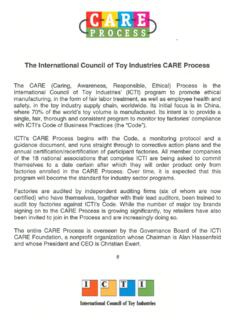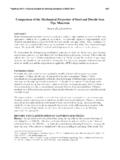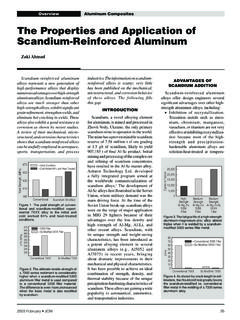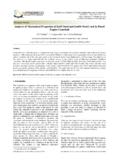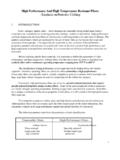Transcription of Safety of toys Part 1: General, mechanical and physical ...
1 The present document was translated into English and revised by independent translators MERCOSUR STANDARD NM-300-1:2002 First edition 2002-12-30 Safety of toys part 1: general , mechanical and physical properties MERCOSUR STANDARDIZATION ASSOCIATION NM-300-1:2002 The present document was translated into English and revised by independent translators Contents Introduction 1 Scope 2 Normative references 3 Definitions 4 Requirements Normal use (see ) Reasonably foreseeable abuse (see ) Material Small parts (see ) Shape, size and strength of certain toys (see ) Edges (see ) Points (see ) Projections (see ) Metal wires and rods (see ) Plastic film or plastic bags in packaging and in toys (see ) Cords and elastics (see ) Folding mechanisms Holes, clearances and accessibility of mechanisms Springs (see ) Stability and overload requirements Enclosures (see ) Simulated protective equipment, such as helmets, hats and goggles (see ) Projectile toys (see ) Aquatic toys (see ) Braking (see ) Toy bicycles (see and ) Speed limitation of electrically driven ride-on toys (see )
2 toys containing a heat source Liquid-filled toys (see ) Mouth-actuated toys (see ) Toy roller skates and toy skateboards Percussion caps (see ) Acoustics (see ) 5 Test methods general Small parts test (see , , and ) Test for shape and size of certain toys (see ) Small balls test (see ) Test for pompoms (see ) Test for preschool play figures (see ) Accessibility of a part or component (see , , , ) Sharp edge test (see and ) Sharp point test (see and ) Determination of thickness of plastic film and sheeting (see ) Test for cords Stability and overload tests (see ) Test for closures and toy chest lids (see ) Impact test for toys that cover the face (see ) Kinetic energy of projectiles, bows and arrows (see ) Free-wheeling facility and brake performance test Determination of speed of electrically driven ride-on toys (see ) Determination of temperature increases (see ) Leakage of liquid-filled toys (see ) Durability of mouth-actuated toys (see ) Expanding materials (see ) Folding or sliding mechanisms Washable toys (see ) NM-300-1.
3 2002 The present document was translated into English and revised by independent translators Test for determination of pentachlorophenol or salts in wooden toys and of certain components of wooden toys (see ) Reasonably foreseeable abuse tests (see ) Determination of emission sound pressure level (see ) Attachments A (informative) Age grading guidelines B (normative) Safety labeling guidelines and manufacturer's markings C (informative) Design guidelines for toys attached to cribs or playpens D (informative) Rationale E (informative) International Classification of toys according to International Council for Children s Play and the Centre National d Information du Jouet (France) F (informative) Comparative chart of physical and mechanical testing compatibility related to Safety of toys between the standards NM 300-1:2002 (MERCOSUR); EN 71-1:1998 (EUROPE) and NBR 11786:1998 (BRAZIL) G (informative) References NM-300-1:2002 1 Foreword The AMN MERCOSUR Standardization Association aims to promote and undertake actions towards harmonization and development of standards within the Southern Common Market MERCOSUR, and is comprised by the National Standardization Agencies of member countries.
4 The AMN performs its standards activities by means of the CSM MERCOSUR Sectorial Committees which were set up for clearly defined action fields. The Draft MERCOSUR Standards, prepared by CSM, are submitted to national vote through the Standards National Agencies of member countries. The acceptance as MERCOSUR Standard through MERCOSUR Standardization Association requires consensus approval by its members. The NM 300 consists of the following parts, under the general title " Safety of toys ": part 1: general , mechanical and physical properties ; part 2: Flammability; part 3: Migration of certain elements; part 4: Experimental sets of chemistry experiments and related activities; part 5: Chemical toys (sets) other than experimental sets; part 6: Safety of electric toys . NM-300-1:2002 The present document was translated into English and revised by independent translators.
5 Introduction This part of MERCOSUR Standard was based on ISO 8124-1:2000 Standard, as well as on the EN 71-1:1998 Standard, with respect to acoustics in the requirements and test methods. general requirements and test methods of national standards of member countries, specifically the NBR 11786:1998 were included, as well as a comparative chart for testing between the different standards. Compliance with the requirements of this part of MERCOSUR Standard will minimize potential hazards associated with toys resulting from their use in their intended play modes (normal use) as well as unintended play modes (reasonably foreseeable abuse). This part of MERCOSUR Standard will not, nor is it intended to, eliminate parental responsibility in the appropriate selection of toys . In addition, this part of MERCOSUR Standard will not eliminate the need for parental supervision in situations where children of various ages may have access to the same toy(s).
6 This part of MERCOSUR Standard includes as normative the Attachment B Safety labeling guidelines and manufacturer's markings. As informative the Attachment A Age grading guidelines, Attachment C Guidelines for the design of toys attached to cribs or playpens, Attachment D Rationale, Attachment E International Classification of toys according to International Council for Children s Play and the Centre National d Information du Jouet (France), Attachment F Comparative chart of testing compatibility of different related to Safety of toys NM 300-1 (MERCOSUR); EN 71-1:1998 (EUROPE) and NBR 11786:1998 (BRAZIL); Attachment G References. NM-300-1:2002 3 Safety of toys part 1: general , mechanical and physical properties 1 Scope The requirements in this part of MERCOSUR standard apply to all toys , any product or material designed or clearly intended for use in play by children under 14 years of age.
7 They are applicable to a toy as it is initially received by the consumer and, in addition, they apply after a toy is subjected to reasonably foreseeable conditions of normal use and abuse unless specifically noted otherwise. The requirements of this part of MERCOSUR standard specify acceptable criteria for structural characteristics of toys , such as shape, size, contour, spacing ( rattles, small parts, sharp points and edges, hinge-line clearances) as well as acceptable criteria for properties peculiar to certain categories of toy ( maximum kinetic energy values for non resilient- tipped projectiles, minimum tip angles for certain ride-on toys ). This part of MERCOSUR standard specifies requirements and test methods for toys intended for use by children in various age groups from birth to 14 years. The requirements vary according to the age group for which a particular toy is intended.
8 The requirements for a particular age group reflect the nature of the hazards and the expected mental and/or physical abilities of the child to cope with them. This part of MERCOSUR standard also requires that appropriate warnings and/or instructions for use be given on certain toys or their packaging. Due to linguistic problems that may occur in different countries, the wording of these warnings and instructions is not specified but given as general information in Attachment B (normative). It shall be noted that different legal requirements exist in many countries with regard to such markings. This part of MERCOSUR standard does not purport to cover or include every conceivable potential hazard of a particular toy or toy category. Except for labeling requirements indicating the functional hazards and the age range for which the toy is intended, this part of MERCOSUR standard has no requirements for those characteristics of toys that represent an inherent and recognized hazard that is integral to the function of the toy.
9 NOTE An example of such a hazard is the sharp point necessary for the proper function of a needle. The needle is a hazard that is well understood by the purchaser of a toy sewing kit, and the functional sharp point hazard is communicated to the user as part of the normal educational process as well as at the point of purchase by means of cautionary labeling on the product s packaging. As a further example, a toy scooter has inherent and recognized hazards associated with its use ( instability during use, especially whilst learning). The potential hazards associated with its structural characteristics (sharp edges, pinch hazards, etc.) will be minimized by compliance with the requirements of this part of MERCOSUR standard. However, taking into account the reference resolution given in MERCOSUR 54/92 concerning Safety of toys , this standard is not applicable to: 1) Christmas and seasonal ornaments, including children party ornaments, with purely ornamental purposes; 2) Reduced scale models of hobby or craft types, driven or not, assembled or not, which in the final product form have not primary value as a toy (for example: decorative folk dolls, soldiers collection, assembly models, etc.
10 ; 3) Equipment of permanent installation , intended for use in public adventure parks or playgrounds; 4) Regulated sport elements and equipment (those with materials, dimensions and weight set in each sports regulations); NM-300-1:2002 The present document was translated into English and revised by independent translators. NOTE It is acknowledged that often there is a subtle difference between, for example, a musical instrument or sports article and their imitation toys . In these cases, the intended use expressed by the manufacturer or distributor, and the normal use and abuse reasonably foreseeable determine if the article is an imitation toy or not. 5) nautical equipment for use in deep waters (waters with a depth equal or larger than m); 6) equipment installed in public places that require tokens or coins for its operation; 7) puzzles with more than 500 pieces, with or without model; 8) compressed air or other gas operated weapons,of the type used in games, practices or sports competitions (see D1); 9) fireworks, including igniters, except those designed to be incorporated into the toy; 10) slingshots, bows and catapults for shooting, whose lengths exceed m when not under tension; 11) darts and arrows with metal tips, except those with magnetic metal discs; 12) vehicles with combustion engines; 13) steam machines; 14) bicycles, designed for sports or use in public roads, with the maximum saddle height exceeding 435 mm.
